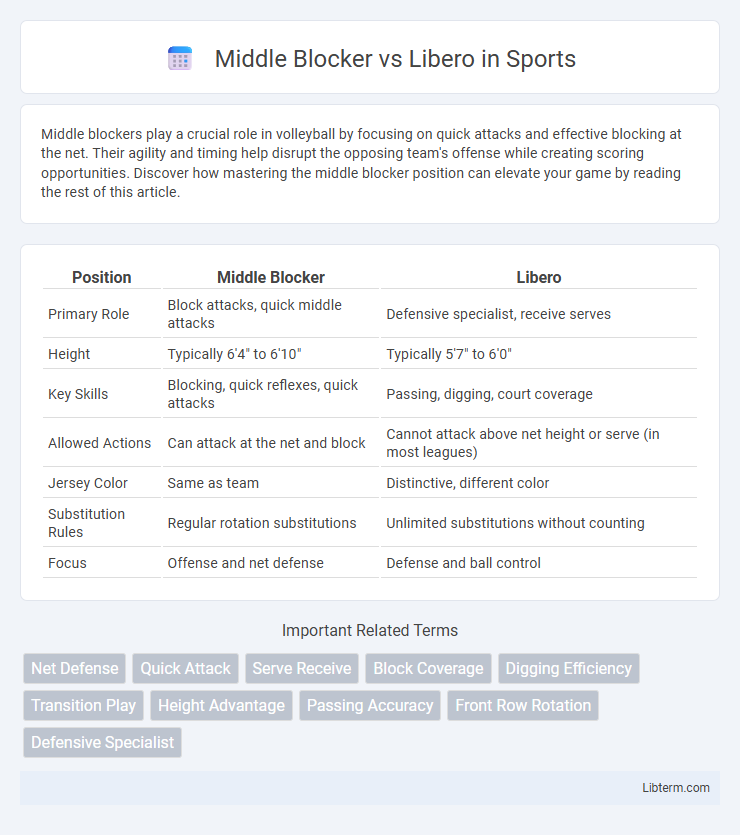Middle blockers play a crucial role in volleyball by focusing on quick attacks and effective blocking at the net. Their agility and timing help disrupt the opposing team's offense while creating scoring opportunities. Discover how mastering the middle blocker position can elevate your game by reading the rest of this article.
Table of Comparison
| Position | Middle Blocker | Libero |
|---|---|---|
| Primary Role | Block attacks, quick middle attacks | Defensive specialist, receive serves |
| Height | Typically 6'4" to 6'10" | Typically 5'7" to 6'0" |
| Key Skills | Blocking, quick reflexes, quick attacks | Passing, digging, court coverage |
| Allowed Actions | Can attack at the net and block | Cannot attack above net height or serve (in most leagues) |
| Jersey Color | Same as team | Distinctive, different color |
| Substitution Rules | Regular rotation substitutions | Unlimited substitutions without counting |
| Focus | Offense and net defense | Defense and ball control |
Understanding the Roles: Middle Blocker vs Libero
The Middle Blocker specializes in front-row defense and quick attacks, primarily responsible for blocking opposing hitters and executing fast-paced offensive plays near the net. The Libero is a defensive specialist focused on receiving serves and digging attacks, often positioned in the back row to enhance ball control and passing accuracy. Understanding these roles highlights the Middle Blocker's emphasis on net play and blocking versus the Libero's crucial contribution to defensive stability and serve reception.
Core Responsibilities on the Court
The Middle Blocker specializes in blocking opponents' attacks at the net, quickly reacting to opposing hitters and executing fast-paced offensive plays like quick sets and slides. The Libero primarily focuses on defensive skills, specializing in receiving serves, digging attacks, and providing accurate passes for setting up offensive plays. While the Middle Blocker operates near the net to control the middle court, the Libero plays in the back row, enhancing overall team defense and ball control.
Physical Demands and Athletic Requirements
Middle Blockers require exceptional height, explosive jumping ability, and lateral quickness for effective blocking and quick attacks at the net. Liberos demand superior agility, reflexes, and cardiovascular endurance to cover the backcourt and execute precise digs and passes. Both positions necessitate high-level hand-eye coordination but differ fundamentally in their focus on vertical power versus continuous floor coverage.
Key Skills and Techniques Compared
Middle Blockers excel in quick lateral movement, powerful blocking, and fast attacks near the net, utilizing strong jumping ability and timing for effective spikes and blocks. Liberos specialize in exceptional digging, precise passing, and quick reflexes to maintain ball control during opponent attacks, often employing agile floor defense techniques. Both require excellent court awareness, but Middle Blockers focus on offensive and net defense skills, while Liberos prioritize defensive coverage and ball distribution.
Positioning and Court Movement Differences
Middle Blockers position themselves near the net's center, focusing on quick lateral movements to block opponent attacks and execute fast hits. Liberos specialize in defensive court coverage, moving fluidly in the back row to receive serves and dig spikes, emphasizing agility and anticipation. The Middle Blocker's court movement is concentrated vertically and laterally near the net, while the Libero covers a wider horizontal range in the backcourt to enhance ball control and defense.
Impact on Team Defense and Offense
Middle Blockers significantly enhance team defense by executing quick blocks against opponents' attacks, often stopping powerful spikes and disrupting offensive flow. Their offensive impact includes fast-paced quick sets and effective hitting in the center of the net, increasing scoring opportunities. Liberos strengthen team defense through exceptional digging and passing skills, improving ball control and facilitating smoother transitions to offense, but they do not contribute directly to front-row attacks.
Strategic Importance in Game Play
Middle Blockers control net dominance by executing quick attacks and blocking opponent hitters, crucial for disrupting offensive plays and creating scoring opportunities. Liberos specialize in defensive strategies with exceptional digging and passing skills, stabilizing ball control and enabling effective counterattacks. Both positions strategically balance offense and defense, making them essential for team coordination and game tempo management.
Training Focus for Each Position
Middle Blockers prioritize explosive power, quick lateral movements, and vertical jump training to enhance blocking and spiking effectiveness at the net. Libero training emphasizes agility, reflexes, and quick footwork to improve defensive coverage and accurate passing in the backcourt. Both positions incorporate endurance and reaction time drills tailored to their specific in-game responsibilities.
Common Challenges Faced by Middles and Liberos
Middle blockers and liberos face distinct challenges shaped by their specialized roles on the volleyball court. Middles must quickly transition from blocking to attacking while reading opponents' setter movements to effectively close gaps, requiring exceptional timing and proximity awareness. Liberos encounter the difficulty of maintaining consistent, precise passes under pressure and covering extensive floor areas to bolster team defense without being involved in front-row attacks.
Choosing the Right Position for Your Skills
Choosing between Middle Blocker and Libero depends heavily on your physical attributes and skill set. Middle Blockers require height, quick reflexes, and strong blocking and attacking abilities, ideal for players who excel at jumping and close net play. Liberos benefit from agility, fast floor defense, and excellent ball control, perfect for those with quick reactions and superior passing skills.
Middle Blocker Infographic

 libterm.com
libterm.com